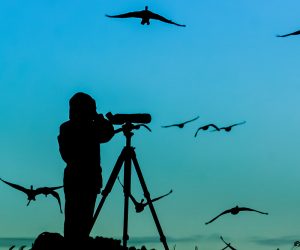 For centuries, the avian world has held a special fascination for people. The incredible diversity of birds, with their often-beautiful plumage, impressive hunting tactics, captivating courting behaviour, their melodic vocalizations, and their aerial acrobatics — no wonder we so admire our feathered friends. Of course, given the ever-curious human mind, admiration very often leads to a desire for a better understanding, a thirst to know the whys and hows of that which captures our interest. This is certainly true in the case of birds, both historically, and today.
For centuries, the avian world has held a special fascination for people. The incredible diversity of birds, with their often-beautiful plumage, impressive hunting tactics, captivating courting behaviour, their melodic vocalizations, and their aerial acrobatics — no wonder we so admire our feathered friends. Of course, given the ever-curious human mind, admiration very often leads to a desire for a better understanding, a thirst to know the whys and hows of that which captures our interest. This is certainly true in the case of birds, both historically, and today.
One of the fundamentals of studying birds these days is banding (i.e., placing distinct markers on the legs of individual birds to learn about the animals’ movement, behaviour and activities). The process is simple. First capture a bird, note the features important to a particular project (e.g., species, sex, age, size, fat deposits, etc.), place a uniquely numbered band on the bird’s leg, release the bird, catalogue the information, and then apply the data to research and management projects. 300,000 birds (representing 300 different species) undergo this process and are banded in Canada each year.
The key strength of banding lies not just in the information gained from the original capture, but in the information that can be garnered from recapture. Once a bird has been banded and its original data recorded, recapture at a later date can indicate myriad bits and pieces of potentially invaluable information, such as the distance and/or routes by which it traveled; any change in its physical condition from one period of time to the next; its potential lifespan; length of time it stayed in, say, a contaminated area and thus was exposed to toxins.
Given all of the important facts illuminated by the process of banding, this activity is seen as serious business. So serious, in fact, that it is the federal governments, on both sides of the border, who regulate who can and cannot participate. Canada and the US jointly administer bird-banding activities, thereby providing an essentially seamless administration of all records and activities pertaining to migratory birds. They are responsible for ensuring that only the most qualified of people are involved in this activity. And good thing too. Banding is considered one of the fundamentals of monitoring birds. Banding contributes towards their conservation — so it had better be done right.
So who can participate? Only permitted “master banders.” These avian enthusiasts have, via various means, proven themselves worthy of such a prestigious title. Aspiring banders must demonstrate not only great skill in capturing and banding birds, they must also be able to correctly identify any and every bird they may encounter in their work (of note, there exists over 500 species of birds in Canada). And these budding banders aren’t just taken at their own word. Before a permit will be handed-out, the hopeful candidate must have several other professionals of the bird world vouch for his or her skills and abilities.
How do these banders go about their job? There are as many capture techniques (e.g., stringing a net across an area through which birds are known to pass, which is termed mist-netting, or baiting and nesting at feeders) as there are band types.
Both the method selected and the type of band used will depend largely on the species of bird being studied. Tiny hummingbirds require unimaginably fine, custom-sized bands, while large birds of prey need bands strong and well-engineered enough to withstand the force of their powerful beaks. Bands for ocean birds must take into account the corroding effect of saltwater; and those for owls and hawks must allow for the fact that the livelihood of these birds depends on the agility of their legs, feet and talons. In addition, some projects require quick visual identification of marked birds, necessitating the use of colour-coded bands. In other words, there are lots of factors to take into consideration in the banding of our avian friends.
So next time you look up and see a flock of birds overhead, watch in awe as an owl swoops silently down on its prey, or casually observe a songbird from your living room window. Grab a pair of binoculars, look hard, and see if you can tell whether a master bander has been at work.

